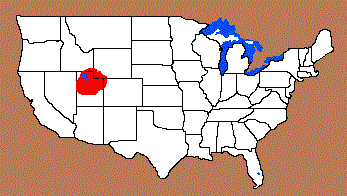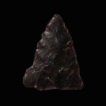Other Websites with Detailed Information:
Name Details:
Named By: Richard N. Holmer and Dennis G. Weder
Named For: Uinta Mountains, Utah
Date Identified: 1980
Type Site:
Uinta
Side Notch
Cluster:
Commonly Utilized Material:
Date:
Cultural Period:
1,200 - 800 B.P.
Developmental
Vandal Minimum to Medieval
Warm
Uinta Fremont Culture
Glacial Period:
Culture:
Outline is Representative of Common Size and Shape:
Description of Physical Characteristics and Flaking Pattern:
This is a small triangular side notch point with a flattened elliptical cross section. The blade may vary form slightly excurvate to straight.
the blade is rarely symmetrical. Parallel notches enter low, one
commonly being higher than the other and one being deeper than the other.
Shoulders range from horizontal to having an upward angle and a short expanded stem. The base is straight to
slightly convex or concave. This point is usually crudely made and
asymmetrical. This type has a random flaking pattern.
Size Measurements: Data Needed
Distribution:
Distribution Comments:
Holmer and Weder place the distribution of this point in the northern distribution of the Fremont culture. Justice (2002) feels that this point is primarily found in the northeastern Utah and into Colorado
and Wyoming within the Uinta Range and surrounding region.

Related / Associated Points:
Additional Comments:
It has been suggested that these points may be related technologically to the Plains Side Notch points (Justice, 2002). It has been noted that these points also closely resemble
Nawthis points, but Holmer and Weder point out that the Nawthis is a longer point and has a higher quality of flaking than commonly seen on the Uinta type (Holmer and Weder, 1980).
Pictures:


Point Validity: Valid Type
Holmer was a well-respected pioneering anthropologist who as a driving force at the Department of Anthropology at the University of Utah. Weder is a distinguished anthropologist who
has conducted extensive studies on Great Basin anthropology and serves as president for the Utah Statewide Archaeological Society. This type was named in a professional publication and has many professional
references. This is considered a valid type.
.
Age Details:
The Uinta Projectile Point are found in association with Uinta Gray ceramics (Holmer and Weder, 1980).
Pictures Provided By:
References: (See Reference Page, Entry Number):
16, 30, 213, 214
Uinta Projectile Point, Uinta Arrowhead

